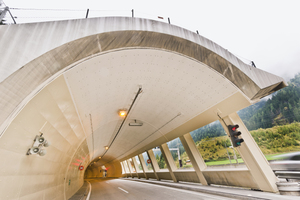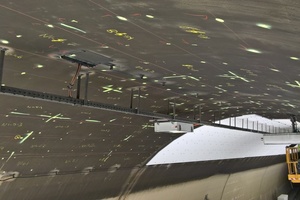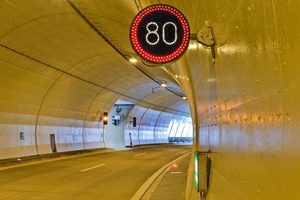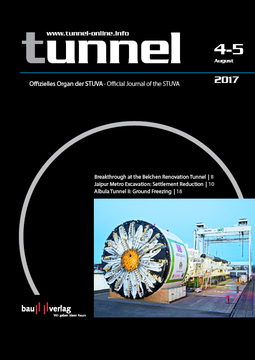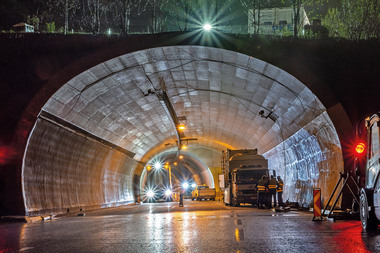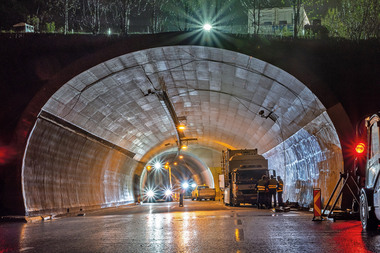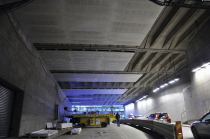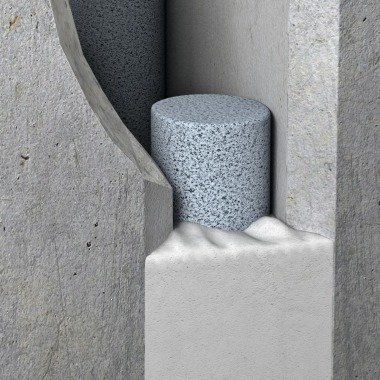Structural Fire Protection in the Strenger Tunnel
The Austrian Strenger Tunnel in Tyrol was fitted with passive fire protection in 2016 within the scope of a rehabilitation scheme. The selected solution involving fire protection boards also includes fire protection plugs and bricks for penetrations. Safety requirements relating to fire prevention could be complied with thanks to the choice of suitable systems. This report looks more closely at how the fire protection materials were installed.
1 Introduction
The Strenger Tunnel, which was built between 2000 and 2005 on the S16 Arlberg expressway, is roughly 5.8 km long and consists of two tubes. This road tunnel, which is located between the tunnels Quadratsch in the east and Flirsch in the west, was built by the New Austrian Tunnelling Method and passes by the community of Strengen at the Arlberg, thus protecting the locality from traffic noise and exhaust emissions [1].
Special attention was paid to passive fire protection, i.e. the protective lining in the vault and gallery segments of the west portal during the redevelopment and upgrading of the tunnel’s safety facilities until December 2016, in addition to the production of fire retarding penetrations using intumescent materials.
Prior to this redevelopment no passive fire protection measures had been installed, with the exception of fire protection doors and fire-retarding sealings for the cable ducts. On account of new regulations the structural set-up and the surrounding conditions called for the implementation of passive fire protection with the aid of fire protection boards [1] over 120 and 125 m long sections at the west portal [3] as well as in the gallery area.
2 Deciding in Favour of the Fire Protection Board System
In Austria essential information for selecting the board thickness is obtained by determining the protective levels for structural fire prevention for road tunnels, established during the course of planning. These protective levels are dealt with at length in the RVS Guideline 09.01.45. Decisive for the choice are the environmental criteria of the tunnel or tunnel section being protected by the boards [4].
During the redevelopment planning process, the Strenger Tunnel was evaluated at Protective Level 2 (Schutzniveau 2), signifying in this particular case fire protection in keeping with an HCINC tunnel fire curve over 90 min. Attention was also paid to the possibility of disassembly for inspection purposes at a subsequent stage [2].
The HCINC tunnel fire curve (also known as HCM tunnel fire curve) is a temperature-time curve, specially applied for tunnel projects. It is based on liquid fires (e.g. petrol or diesel pool fires) attaining temperatures of up to 1300 °C after a very short time, retaining this maximum temperature constantly over a stipulated period [4]. In addition to RVS 09.01.45, which relates to fire protection in road tunnels, in Austria there is a further guideline applying to this topic namely “Protective Layers for enhanced Fire Protection for Underground Transportation Structures” (ÖBV Guideline “Schutzschichten für den erhöhten Brandschutz für unterirdische Verkehrsbauwerke”). It describes the curve relating to the project as a modified hydrocarbon curve [5]. In addition, planning also called for a maximum 300 °C interface temperature (concrete temperature directly behind the fire protection boards) after a duration of 90 min and the required tunnel fire curve [3].
In the case of the Strenger Tunnel the decision in favour of the fire protection boards was taken on account of the good state of the inner shell and the construction logistics [1]. Christoph Wanker, ASFINAG project manager for redeveloping the Strenger Tunnel, provided the following reason for choosing fire protection boards as a structural fire prevention method: “Compared with the alternative solution of placing shotcrete, the applied solution involving fire protection boards possesses undoubted advantages. Alongside flexibility of installation in the tunnel cross-section and above all, in the proximity of existing facilities, the fact that traffic and other activities are only minimally hampered must be underlined. This was largely responsible for deciding in favour of a system using fire protection boards”.
3 Assembling the Fire Protection Boards
A roughly 5000 m² surface area in the gallery and vault sectors of the west portals of both tubes was covered with fire protection boards for the Strenger Tunnel. Within the scope of the tunnel’s complete rehabilitation it was essential to first close the north tube, leaving the south one open for traffic in order to ensure that traffic could still pass through. Subsequently, the north tube was opened to carry traffic so that renovation activities could be undertaken in the south tube. The application of the fire protection boards took five weeks per tunnel tube and was carried out by Lindner Isoliertechnik und Industrieservice Österreich.
The fire protection requirements determined for this project were fulfilled using a tunnel construction board with a board thickness of 20 mm. The choice of a suitable fixing agent in the proper material quality was also of great significance. The combination of the calcium-silicate fire protection boards and the high corrosion-resistant nail anchors FNA II 6x30 M6/30 including washers and safety nuts from Fischer in quality 1.4529 also allows for subsequent disassembly to be able to undertake inspections without causing damage to the fire protection boards. The material selected for the tunnel construction boards used for the Strenger Tunnel is resistant to fire in accordance with high-temperature tunnel fire curves as well as possessing a frost-thaw resistance in keeping with EN 12467 as described in the previously cited ÖBV Guideline [5].
For the Strenger Tunnel’s vault area, fire protection boards with the dimensions 2500 x 598 x 20 mm were assembled. The selected calcium-silicate fire protection board has the positive characteristic that it can be subsequently bent, then inserted and assembled in the vault. However, if the tunnel structure’s diameter is too small in comparison with the board thickness – as was the case for the Strenger Tunnel – it is advisable to install the boards polygonally without bending the material. The fire protection boards installed in the vault area were attached using ten nail anchors per board. It was essential to ensure that the fixing agent was distributed evenly over the board and also to pay attention to the anchorage depth in order to counter the anticipated suction and pressure effects within the tunnel.
ASFINAG’s insistence on an intact reinforcement was complied with through a complete reinforcement scan including documentation prior to the fire protection boards being assembled. It is not necessary to backfill the calcium-silicate tunnel construction board with appropriate strips of the same material for fire prevention purposes so there was no need to employ this method for this project either.
There was an additional requirement in conjunction with applying the structural fire protection, taking into account the possibility of diverting water at the tunnel wall behind the coated fire protection boards. This was achieved by using sufficiently thick spacing strips, which were anchored in the concrete during the assembly of the calcium-silicate boards thus catering for the gap between the tunnel wall and the board.
4 Coating the Fire Protection Boards
The tendering documents for rehabilitating the Strenger Tunnel called for the fire protection boards in the wall section to be coated in order to produce a smooth surface with a suitable degree of reflection, which can also be easily cleaned [2].
Such a coating for calcium-silicate boards represented a pilot project in Austria. Following prior tests, a system solution with a water-dispersing impregnation and similar water-dispersing epoxide resin coating as top coat was evolved in collaboration with the coating manufacturer AvenariusAgro. In this way, as required, the surfaces and ends of the fire protection boards were coated up to a height of 4 m in the wall area with the colour RAL 1015 (light ivory). The rear side of the fire protection boards was also impregnated in order to prevent the possible entry of moisture at the back and thus protect the coating on the front side and the ends from damage caused by moisture. The selected system combining fire protection board and coating is one the one hand, relatively easy to clean and on the other, provides a functional surface appearance with corresponding degree of reflection to safeguard motorists.
5 Fire Protection for Penetration Areas
Sealings represent a further fire prevention topic for tunnel structures. In the case of the Strenger Tunnel these were to be produced in the cable ducts in the floor, in the emergency recesses and cross-passages. Towards this end, Promastop-B fire protection bricks and Promastop-P fire protection plugs were applied – perma-elastic materials that are intumescent in the event of fire, which are also distinguished through their smoke-gas tightness. The great advantage of such a penetration system is to be found in the straightforward and rapid assembly for those processing the materials as well as its suitability for tunnel structures.
6 Summary and Outlook
Passive fire prevention in tunnel structures has increasingly gained in importance in Austria in recent years. Through the application of products for structural fire protection it is possible to greatly increase safety in tunnels. This applies both to the safety of motorists as well as the structures themselves.
Through the installation of coated fire protection boards in the Strenger Tunnel, an outstanding reference for the successful application of passive fire prevention was created, which possesses the great advantage of providing a pleasant surface appearance for road users in addition to the main demands posed on fire resistance.

